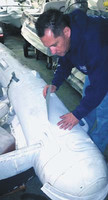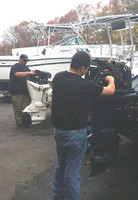With all the great weather we have been having you may have taken your inflatable dinghy out for a few last runs on the bay, but, sadly, now you need to think about winterizing it and the outboard …
This item is available in full to subscribers.
We have recently launched a new and improved website. To continue reading, you will need to either log into your subscriber account, or purchase a new subscription.
If you are a current print subscriber, you can set up a free website account by clicking here.
Otherwise, click here to view your options for subscribing.
Please log in to continue |
|


With all the great weather we have been having you may have taken your inflatable dinghy out for a few last runs on the bay, but, sadly, now you need to think about winterizing it and the outboard too. I went down to Dawn Lane in Apponaug and scouted out Mark Bouressa of New England Inflatables. When I asked him for some words of wisdom on storing inflatables, his first caution was damage from mice. If you roll or fold up your dinghy, the critters love to chew it. It is better to leave it inflated, maybe on the trailer. He also emphasized a good washing and if you use a power washer, use the wand rather than the pencil setting or it can rip the fabric. Stand it on end and get all the grit, sand, and even bottle caps from under floorboards. Do not use solvents! Use some of the cleaning products specifically made for inflatables, a scrubbie, and get to work. Rinse it off well with a hose so it does not discolor. When it is dry, there are some good preservatives with SPF ratings of 40 that you can apply for UV protection.
How do you tackle barnacles? Be careful about using a rigid scraper. It can cut right into the material. Don’t let barnacles calcify. Clean off with a scrub pad while they are softer. If they have already calcified, the disk is brittle and it may be best for you to take the dinghy to a professional to take off with a special grinding tool. Consider putting on bottom paint and avoid this problem. You would have to use a very soft grade of paint or it splinters and cracks.
Of course it is better to store the inflatable inside a shed or garage, but if you store it outside it is essential to cover it. Even in winter, sunlight degrades fabric. CSM (hypalon) material has good UV durability while PVC material is most susceptible to degradation, but both need the protection of plastic or at least a tarp. Make the middle the highest point so rain and melting snow will run off.
With the dinghy, of course, comes the motor. I visited Russ Wood, a mechanic with 28 years of experience, from Wood Boat and Motor in Apponaug and asked for some tips on winterizing your outboard motor. He suggested that on the last three or four trips on the bay you should gradually add stabilizer to your fuel. In that way it goes throughout your engine and is better than trying to do it all at once when you are done for the season.
You should change filters and all your spark plugs too. Be careful with this if you have an engine that requires indexing of the plugs. They have to go in a certain way with the electrodes facing correctly or it won’t run properly. Read your owner’s manual!
When you change the oil, spend the money for a good quality oil. It really will make a difference. Russ advised leaving as little fuel as possible in your gas tank. Remember, in September you are getting a winter blend, and in May you will get a spring blend. Better not to mix the two. When you change the oil, you need to change the lower gear and seals as well. As far as fogging out your engine, don’t put in too much fogging oil. Pour it in until you see a little smoke and then turn the engine off. As far as antifreeze, remember, your engine is designed for the water to run down and right out. You do not need to put in antifreeze. If you go to a professional, bring the serial number of the motor and check with your dealer to find the year of your engine so you will get the right parts.
A little care now will save a lot of time in the spring, and you can get out on the water sooner.
Trivia Question: Using chain instead of line for your anchor rode, how much chain should you put out to anchor in 20 ft of water? For the answer, go to www.Northstarflotilla.com.
Safe Boating!
Comments
No comments on this item Please log in to comment by clicking here